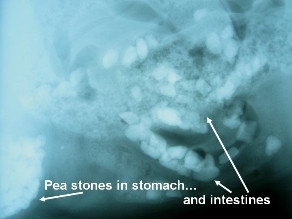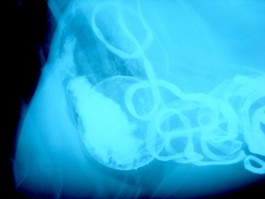Are you worried about your dog eating rocks? This comprehensive guide from rockscapes.net will explore the dangers of rock ingestion, symptoms to watch for, and what to do if your dog has eaten rocks, offering practical advice and actionable steps. Learn how to protect your furry friend with tips on landscaping with rocks safely and alternative chew toys. Discover peace of mind and create a safe environment for your canine companion with our detailed insights, focusing on canine safety and pet health.
1. Why Do Dogs Eat Rocks? Understanding the Behavior
Why do dogs eat rocks? Rock eating, also known as pica, can stem from various reasons, including nutritional deficiencies, boredom, anxiety, or underlying medical conditions. According to research from the American Kennel Club (AKC), puppies often explore the world through their mouths, leading them to ingest non-food items. However, persistent rock eating in adult dogs may indicate a more serious issue.
1.1. Common Reasons for Rock Consumption
Several factors can contribute to a dog’s rock-eating behavior:
- Nutritional Deficiencies: A lack of essential vitamins and minerals can lead dogs to seek out these nutrients from unusual sources, including rocks.
- Boredom and Anxiety: Dogs left alone for extended periods or those experiencing anxiety may turn to rock eating as a way to relieve stress or entertain themselves.
- Medical Conditions: Certain medical conditions, such as anemia or gastrointestinal issues, can also trigger pica. A study published in the Journal of Veterinary Internal Medicine found a correlation between gastrointestinal disorders and pica in dogs.
- Dental Problems: Dogs with dental problems may chew on rocks to alleviate discomfort.
- Learned Behavior: Puppies may learn rock-eating behavior from their mothers or other dogs.
1.2. The Role of Breed and Age
Breed and age can also play a role in rock-eating behavior. Some breeds, such as Labrador Retrievers and Golden Retrievers, are known for their tendency to ingest foreign objects. Puppies, with their natural curiosity and exploratory behavior, are also more likely to eat rocks than adult dogs. Understanding these factors can help you better manage and prevent rock eating in your dog.
2. The Dangers of Rock Ingestion: What Happens When Dogs Eat Rocks?
What are the dangers of rock ingestion? Rock ingestion can pose significant health risks to dogs, ranging from mild gastrointestinal upset to life-threatening intestinal blockages. A small rock may pass without issue, but larger rocks can cause serious complications.
2.1. Immediate Risks: Choking and Oral Injuries
The most immediate risks associated with rock ingestion include choking and oral injuries. A dog may choke if a rock becomes lodged in its throat, preventing them from breathing. Additionally, chewing on rocks can cause cuts, abrasions, and other injuries to the mouth and teeth.
2.2. Gastrointestinal Issues: Vomiting and Diarrhea
If a dog manages to swallow a rock, it can cause a range of gastrointestinal issues. The rock can irritate the lining of the stomach and intestines, leading to vomiting, diarrhea, and abdominal pain. In some cases, the rock may be small enough to pass through the digestive system without causing significant problems, but this is not always the case.
2.3. Intestinal Blockage: A Life-Threatening Emergency
One of the most serious risks of rock ingestion is intestinal blockage. If a rock is too large to pass through the digestive tract, it can become lodged in the intestines, blocking the flow of food and fluids. This can lead to a buildup of pressure, causing severe pain, vomiting, and dehydration. Intestinal blockage is a life-threatening emergency that requires immediate veterinary attention. According to the American Animal Hospital Association (AAHA), surgery is often necessary to remove the obstruction and prevent further complications.
2.4. Long-Term Complications: Internal Damage
Even if a rock passes through the digestive system without causing a complete blockage, it can still cause long-term damage. The sharp edges of rocks can scrape and irritate the lining of the stomach and intestines, leading to inflammation and scarring. Over time, this can contribute to chronic gastrointestinal problems and reduced nutrient absorption.
3. Can Dogs Pass Small Rocks? Understanding the Possibilities
Can Dogs Pass Small Rocks? Whether a dog can pass small rocks depends on the size of the rock, the dog’s size, and the overall health of their digestive system. In some cases, small rocks may pass through the digestive tract without causing significant problems.
3.1. Factors Influencing Passage
Several factors influence whether a dog can pass small rocks:
- Rock Size: Smaller rocks are more likely to pass than larger ones. Rocks that are less than an inch in diameter may be able to move through the digestive system without causing a blockage.
- Dog Size: Larger dogs typically have wider digestive tracts, making it easier for them to pass small rocks. Smaller dogs are at a higher risk of intestinal blockage due to their narrower digestive systems.
- Digestive Health: A healthy digestive system with normal motility is more likely to pass rocks without complications. Dogs with underlying gastrointestinal issues may have difficulty passing rocks.
- Rock Shape: Smooth, round rocks are easier to pass than jagged or sharp rocks. Sharp rocks can cause damage to the lining of the digestive tract, increasing the risk of complications.
3.2. What Happens During Digestion?
When a dog swallows a rock, it enters the stomach, where it is exposed to stomach acid and digestive enzymes. These substances can help break down some of the rock’s material, making it easier to pass. However, larger rocks may remain intact and move into the small intestine. If the rock is small enough, it may continue to move through the digestive tract and eventually be eliminated in the feces.
3.3. Signs That a Rock May Not Pass
Even if a rock is small, there is still a risk that it may not pass. Signs that a rock may not pass include:
- Vomiting: Frequent or persistent vomiting can indicate that the rock is irritating the stomach or causing a partial blockage.
- Loss of Appetite: A decreased appetite or refusal to eat can be a sign that the dog is experiencing abdominal pain or discomfort.
- Lethargy: A lack of energy or decreased activity level can indicate that the dog is not feeling well.
- Abdominal Pain: Signs of abdominal pain may include a hunched posture, reluctance to move, or guarding the abdomen.
- Constipation: Difficulty passing stool or the absence of stool can indicate a blockage in the intestines.
If you notice any of these signs, it is important to seek veterinary attention immediately.
4. What to Do If Your Dog Swallowed a Rock: Immediate Steps
What steps should you take if your dog swallows a rock? If you suspect that your dog has swallowed a rock, it is important to take immediate action. While it may be tempting to wait and see if the rock passes on its own, this can be risky.
4.1. Contact Your Veterinarian Immediately
The first and most important step is to contact your veterinarian immediately. Explain the situation and provide as much information as possible, including the size and type of rock, the dog’s size and breed, and any symptoms the dog is experiencing. Your veterinarian can provide guidance on the best course of action.
4.2. Do Not Induce Vomiting Without Veterinary Guidance
While it may be tempting to induce vomiting to try to dislodge the rock, this is generally not recommended without veterinary guidance. Inducing vomiting can be dangerous, especially if the rock is large or has sharp edges. It’s also important to note that according to the Pet Poison Helpline, certain substances, like hydrogen peroxide, can be harmful if not administered correctly. Always consult with your veterinarian before attempting to induce vomiting.
4.3. Monitor Your Dog Closely
While waiting for veterinary advice, monitor your dog closely for any signs of distress or complications. Watch for vomiting, loss of appetite, lethargy, abdominal pain, and difficulty passing stool. If you notice any of these signs, seek immediate veterinary attention.
4.4. Follow Veterinary Recommendations
Your veterinarian may recommend a variety of treatments, depending on the size and location of the rock and the dog’s overall condition. These may include:
- X-rays or Ultrasound: These imaging techniques can help determine the location and size of the rock and assess whether it is causing a blockage.
- Induced Vomiting: In some cases, your veterinarian may recommend inducing vomiting to try to dislodge the rock. This should only be done under veterinary supervision.
- Endoscopy: An endoscope is a flexible tube with a camera that can be used to visualize the stomach and intestines. Your veterinarian may be able to use an endoscope to retrieve the rock without surgery.
- Surgery: If the rock is causing a complete blockage or cannot be removed with an endoscope, surgery may be necessary to remove the obstruction.
5. Veterinary Treatment Options: From Diagnosis to Recovery
What are the veterinary treatment options for rock ingestion? Veterinary treatment for rock ingestion can vary depending on the severity of the case. Your veterinarian will conduct a thorough examination and may recommend diagnostic tests to determine the best course of action.
5.1. Diagnostic Tests: X-rays and Ultrasounds
Diagnostic tests play a crucial role in determining the location and size of the rock and assessing the extent of any damage. X-rays are commonly used to visualize the rock, but they may not always be effective if the rock is small or not radiopaque. Ultrasounds can provide more detailed images of the stomach and intestines and help identify any blockages or inflammation.
 Stones in a dog's stomach
Stones in a dog's stomach
5.2. Non-Surgical Options: Induced Vomiting and Endoscopy
In some cases, non-surgical options may be sufficient to remove the rock. If the rock is small and located in the stomach, your veterinarian may recommend inducing vomiting to dislodge it. This should only be done under veterinary supervision, as it can be dangerous if not performed correctly. Endoscopy is another non-surgical option that involves using a flexible tube with a camera to visualize the stomach and intestines. Your veterinarian may be able to use specialized instruments to grab and remove the rock through the endoscope.
5.3. Surgical Intervention: When Is It Necessary?
Surgical intervention is necessary when the rock is causing a complete blockage or cannot be removed with non-surgical methods. Surgery typically involves making an incision in the abdomen to access the stomach or intestines and remove the rock. In some cases, it may be necessary to remove a portion of the intestine if it has been damaged by the rock.
5.4. Post-Operative Care: Ensuring a Smooth Recovery
After surgery, your dog will require careful post-operative care to ensure a smooth recovery. This may include:
- Pain Management: Your veterinarian will prescribe pain medication to help manage any discomfort.
- Antibiotics: Antibiotics may be given to prevent infection.
- Fluid Therapy: Intravenous fluids may be necessary to maintain hydration.
- Dietary Restrictions: Your veterinarian may recommend a bland, easily digestible diet for several days after surgery.
- Activity Restrictions: It is important to restrict your dog’s activity level to allow the surgical site to heal properly.
Regular follow-up appointments with your veterinarian are essential to monitor your dog’s progress and address any complications.
6. Preventing Rock Eating: Practical Tips for Dog Owners
How can you prevent your dog from eating rocks? Preventing rock eating is crucial for protecting your dog’s health and well-being. Several strategies can help reduce or eliminate this behavior.
6.1. Managing the Environment: Removing Temptations
One of the most effective ways to prevent rock eating is to manage your dog’s environment. Remove any rocks or stones from your yard or areas where your dog spends time. If this is not possible, consider using a barrier or fencing to prevent your dog from accessing these areas.
6.2. Providing Alternative Chew Toys
Boredom and anxiety are common triggers for rock eating. Providing your dog with a variety of alternative chew toys can help redirect their attention and satisfy their chewing instincts. Choose toys that are durable, safe, and appropriate for your dog’s size and chewing style.
6.3. Addressing Underlying Issues: Training and Enrichment
Addressing underlying issues such as boredom, anxiety, or nutritional deficiencies can also help prevent rock eating. Provide your dog with plenty of exercise, mental stimulation, and social interaction. Consider enrolling in obedience training classes to teach your dog commands such as “leave it” and “drop it.” Consult with your veterinarian to rule out any underlying medical conditions or nutritional deficiencies.
6.4. Using Taste Deterrents
Taste deterrents can be applied to rocks or other objects to discourage your dog from chewing on them. These products typically have a bitter or unpleasant taste that dogs find unappealing. However, it is important to choose a taste deterrent that is safe for dogs and follow the manufacturer’s instructions carefully.
7. Landscaping with Dogs in Mind: Creating a Safe Outdoor Space
How can you landscape your yard to be dog-friendly? Landscaping with dogs in mind involves creating a safe and enjoyable outdoor space for your furry friend. This includes choosing dog-friendly materials, designing a functional layout, and incorporating features that cater to your dog’s needs.
7.1. Choosing Dog-Friendly Materials
When landscaping with dogs, it is important to choose materials that are safe, durable, and easy to maintain. Avoid using materials that could be harmful if ingested, such as small rocks or gravel. Opt for larger stones or mulch that are less likely to be swallowed.
7.2. Designing a Functional Layout
Design a functional layout that provides your dog with plenty of space to roam and play. Create designated areas for different activities, such as a digging pit, a play area, and a shaded resting spot. Consider using dog-friendly ground covers such as grass, clover, or wood chips.
7.3. Avoiding Toxic Plants
Many common landscaping plants are toxic to dogs. Avoid using these plants in your yard and choose dog-friendly alternatives instead. The American Society for the Prevention of Cruelty to Animals (ASPCA) provides a comprehensive list of toxic and non-toxic plants for dogs.
7.4. Providing Shade and Water
Dogs are susceptible to heatstroke, so it is important to provide them with plenty of shade and fresh water, especially during hot weather. Plant trees or shrubs to create shaded areas and provide a constant supply of fresh water in a dog-friendly bowl or fountain.
8. Rockscapes and Dog Safety: Finding the Right Balance
How can you balance rockscapes and dog safety? Balancing rockscapes and dog safety requires careful planning and consideration. While rockscapes can add beauty and functionality to your yard, they can also pose risks to dogs if not properly designed and maintained.
8.1. Choosing the Right Types of Rocks
When incorporating rocks into your landscape, choose types that are less likely to be swallowed by your dog. Opt for larger stones that are too big to fit in your dog’s mouth. Avoid using small gravel or pebbles that can be easily ingested.
8.2. Securing Rocks in Place
Secure rocks in place to prevent them from being dislodged or moved by your dog. Use landscaping adhesive or bury the rocks partially in the ground to keep them stable. This will also help prevent your dog from digging around the rocks and potentially ingesting them.
8.3. Monitoring Your Dog’s Behavior
Monitor your dog’s behavior around rockscapes and intervene if you notice them chewing on or attempting to swallow rocks. Redirect their attention to a safe chew toy or engage them in a different activity.
8.4. Regular Maintenance
Regular maintenance is essential for keeping your rockscapes safe for your dog. Inspect the rocks regularly for any signs of damage or instability. Remove any small rocks or debris that could be ingested.
9. Alternative Chew Options: Safe and Engaging Toys for Dogs
What are safe and engaging alternatives to chewing rocks? Providing your dog with safe and engaging chew options is essential for preventing rock eating and promoting their overall well-being.
9.1. Durable Rubber Toys
Durable rubber toys are a popular choice for dogs who love to chew. Choose toys that are made from high-quality, non-toxic rubber and are designed to withstand heavy chewing. Look for toys that can be stuffed with treats or peanut butter to provide added stimulation.
9.2. Rope Toys
Rope toys are another safe and engaging option for dogs. Choose toys that are made from durable, non-toxic materials and are designed to withstand heavy chewing. Supervise your dog while they are playing with rope toys to prevent them from ingesting any of the fibers.
9.3. Puzzle Toys
Puzzle toys are a great way to provide mental stimulation and keep your dog entertained. These toys require your dog to solve a puzzle to access treats or food, which can help redirect their attention away from rocks.
9.4. Edible Chews
Edible chews, such as dental chews or bully sticks, can also be a safe and engaging option for dogs. Choose chews that are made from natural ingredients and are appropriate for your dog’s size and chewing style. However, it is important to monitor your dog while they are chewing on edible chews to prevent them from swallowing large pieces. As the original article states, rawhide treats, pig ears, and cow hooves, may cause harm to your dog.
 Dog with a toy
Dog with a toy
10. When to Seek Professional Help: Consulting with Veterinarians and Behaviorists
When should you seek professional help for your dog’s rock-eating habit? While many cases of rock eating can be managed with environmental modifications and alternative chew options, some dogs may require professional help.
10.1. Persistent Rock Eating Despite Interventions
If your dog continues to eat rocks despite your best efforts to manage their environment and provide alternative chew options, it is important to seek professional help. Persistent rock eating can indicate an underlying medical or behavioral issue that requires treatment.
10.2. Signs of Underlying Medical Conditions
If your dog is exhibiting other signs of illness, such as vomiting, diarrhea, loss of appetite, or lethargy, it is important to consult with your veterinarian to rule out any underlying medical conditions. Certain medical conditions can trigger pica, and treating these conditions may help resolve the rock-eating behavior.
10.3. Behavioral Issues and Anxiety
If your dog’s rock-eating behavior is related to anxiety or other behavioral issues, a veterinary behaviorist can help develop a treatment plan that addresses the underlying causes of the behavior. This may involve medication, behavior modification techniques, or a combination of both.
10.4. Working with a Veterinary Behaviorist
A veterinary behaviorist is a veterinarian who specializes in the diagnosis and treatment of behavioral problems in animals. They can provide expert guidance on how to manage and modify your dog’s rock-eating behavior. To find a veterinary behaviorist in your area, consult with your veterinarian or visit the website of the American College of Veterinary Behaviorists (ACVB).
Address: 1151 S Forest Ave, Tempe, AZ 85281, United States
Phone: +1 (480) 965-9011
Website: rockscapes.net
FAQ: Addressing Common Concerns About Dogs and Rocks
1. Is Rock Eating Common in Dogs?
Yes, rock eating, or pica, is relatively common in dogs, especially puppies. It can stem from curiosity, boredom, nutritional deficiencies, or underlying medical conditions.
2. Can a Dog Digest a Rock?
No, dogs cannot digest rocks. Stomach acids may break down some of the rock’s material, but most of it remains intact, posing risks of gastrointestinal upset or blockage.
3. How Long Does It Take for a Dog to Pass a Small Rock?
It can take anywhere from 24 to 72 hours for a dog to pass a small rock, depending on the dog’s size, digestive health, and the size and shape of the rock.
4. What Are the Symptoms of Rock Ingestion in Dogs?
Symptoms of rock ingestion in dogs include vomiting, loss of appetite, lethargy, abdominal pain, constipation, and difficulty passing stool.
5. What Should I Do If My Dog Ate a Rock?
If your dog ate a rock, contact your veterinarian immediately. Do not induce vomiting without veterinary guidance. Monitor your dog closely for any signs of distress or complications.
6. Can Rock Eating Cause Permanent Damage?
Yes, rock eating can cause permanent damage, such as inflammation, scarring, and chronic gastrointestinal problems. In severe cases, it can lead to intestinal blockage, which can be life-threatening.
7. How Can I Prevent My Dog from Eating Rocks?
You can prevent your dog from eating rocks by managing their environment, providing alternative chew toys, addressing underlying issues, and using taste deterrents.
8. Are Certain Breeds More Prone to Rock Eating?
Yes, some breeds, such as Labrador Retrievers and Golden Retrievers, are known for their tendency to ingest foreign objects, including rocks.
9. Can Anxiety Cause Rock Eating in Dogs?
Yes, anxiety can cause rock eating in dogs. Dogs may turn to rock eating as a way to relieve stress or entertain themselves.
10. When Should I Consult a Veterinary Behaviorist?
You should consult a veterinary behaviorist if your dog’s rock-eating behavior is persistent despite your best efforts to manage it, or if it is related to anxiety or other behavioral issues.
Ready to create a safer, more beautiful outdoor space for your canine companion? Visit rockscapes.net today for inspiration, expert advice, and high-quality materials to transform your landscape. Explore our wide selection of dog-friendly rocks, get design ideas, and connect with our team of experts to bring your vision to life. Don’t wait, start building your dream rockscape today.

